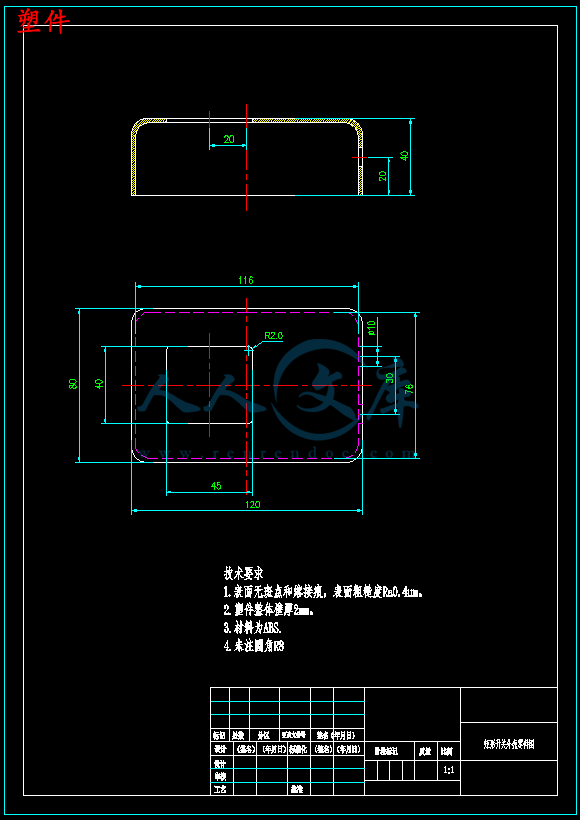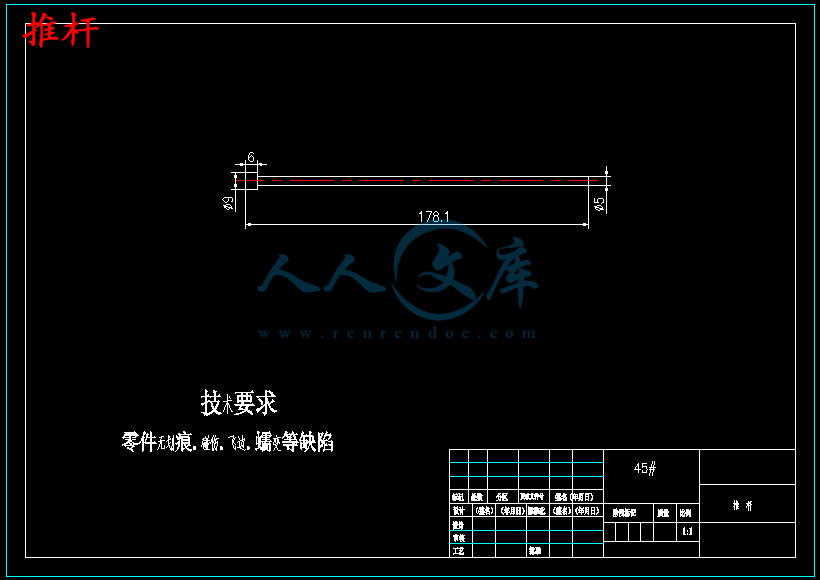【温馨提示】 购买原稿文件请充值后自助下载。
以下预览截图到的都有源文件,图纸是CAD,文档是WORD,下载后即可获得。
预览截图请勿抄袭,原稿文件完整清晰,无水印,可编辑。
有疑问可以咨询QQ:414951605或1304139763
矩形开关外壳注塑模具设计
【摘要】
本文以矩形罩壳为对象,详细介绍其注射模设计过程。设计中主要运用PRO/ENGINEER软件,根据制件的零件图进行零件的三维造型,并在对该模型进行成型性分析的基础上,进行了必要的计算和结构设计。采用模具专家系统EMX,提高了设计效率。通过Autocad完成工程图的制作,根据注塑的额定注塑量我们可以确定模具的型腔为一模2腔,排列方式为直线对称排列,制件有侧孔,无法直接脱模,所以我们需要设计侧抽芯机构,利用斜导柱带动滑块来完成侧孔的横向抽芯,最后当主流道余料全部被拉出后,再利用推杆推出机构完成塑件的推出。由于塑件比较大,所以需要设计冷却系统对制件进行局部冷却,防止制件发生翘曲变形设计中综合考虑了各方面的因素并通过调研对模具进行了估价。
关键词:矩形罩壳;三维造型;注塑模;设计。
ABSTRACT
The graduation design topic is: rectangular casing of the plastic parts injection mould. Based on rectangular casing for object, detailed introduces the injection mould design process. The main design using PRO/e software, according to the product's part drawing for components of the three-dimensional modelling, and on the model based on the analysis of the formability, the necessary calculation and structural design. According to the rated the injection quantity and injection we can determine the mold cavity as a mold 2 cavity, the arrangement of linear symmetrical arrangement, parts with side holes, can not be directly release, so we need to design of side core pulling mechanism, lateral core pulling the slanted guide pillar drives the sliding block to complete the side hole, when more than the mainstream the material is pulled out, the rod with the agency to complete the introduction of plastic parts. Because the plastic is relatively large, so it is necessary to design the cooling system to prevent the local cooling parts, parts warpage.EMX adopted mould expert system and improve the design efficiency. Finally through the Autocad complete engineering drawing production, design of the comprehensive consideration of various factors and through the investigation to the mold for the valuation.
Keywords: Three dimensional modelling; Proe; EMX; Rectangular casing
目 录
前 言 1
1.塑料制品工艺分析 4
2. 塑料的成型特性及工艺参数 6
3. 注塑设备的选择 8
3.1 计算塑件的体积和重量 8
3.2 确定型腔数选择注塑机 8
3.3注塑机基本参数 9
4. 塑料件的工艺尺寸的计算 11
5. 浇注系统 14
5.1 分型面的选择 14
5.2 浇口套的选用 15
5.3 分流道的布置 15
5.4 浇口的设计 16
6. 抽芯机构的设计与合模导向结构设计 17
6.1脱模结构设计 17
6.2合模导向机构的设计 17
6.3侧抽芯机构的设计 18
6.3.1抽拔距的计算 19
6.3.2斜导柱的尺寸与安装形式 19
7. 温度系统与排气系统的设计 21
7.1 排气系统的设计 21
7.2 温度控制系统的设计 21
8. 注射机有关工艺参数的校核 24
8.1注射量及锁模力的校核 24
8.2注射机安装模具部分的尺寸校核 25
9. 零件材料的定制及模具的安装试模 26
结 论 31
致 谢 32
参考文献 33
附 录 34
前 言
本次设计主要运用PRO / ENGINEER软件进行模具的设计、分析, 包括初期零件的三维造型以及以此模型为基础进行的厚度、质量和投影面积的分析。其次根据三维模型进行模具分型面的设计、确定型腔和型芯、模具结构的详细设计、塑件充填过程分析、采用模具专家系统EMX进行的模架设计等几个方面。
需要分析的问题是:塑料在型腔内的注射过程中流动情况,温度压力变化情况、注塑件残余应力等, 根据分析检查模具结构、流动状态、产品质量等问题。如是否存在浇注系统不合理, 流道和浇口位置尺寸是否不当, 型腔平衡以及产品的翘曲变形等。设计完成后,最后通过Autocad完成工程图的制作。模具是工业生产的重要装备,是国民经济的基础设备,是衡量一个国家和地区工业水平的重要标志。模具在电子、汽车、电机、电器、仪器仪表、家电和通讯产品制造中具有不可替代的作用,是工业发展的基石,被人称为“工业之母”和“磁力工业”。
模具是制造业的重要基础装备,是工业化国家实现产品批量生产和新产品研发所不可缺少的工具。用模具生产制品所表现出来的高效率、低消耗、高一致性、高精度和高复杂程度是其他任何制造方法所不及的。换句话说,没有高水平的模具就不会有高水平的工业产品。模具业是否强盛也反映出一个国家工业的强弱。
(1)塑料制品和注射成形在模具业的重要地位
塑料制品具有原料来源丰富,价格低廉,性能优良等特点。它在电脑、手机、汽车、电子、汽车、电机、电器、仪器仪表、家电和通讯产品制造中具有不可替代的作用,应用极其广泛。
注射成形是成形热塑件的主要方法,因此应用范围很广。注射成形是把塑料原料放入料筒中经过加热熔化,使之成为高黏度的流体,用柱塞或螺杆作为加压工具,使熔体通过喷嘴以较高压力注入模具的型腔中,经过冷却、凝固阶段,而后从模具中脱出,成为塑料制品。
塑料注射成形工艺的最大特点是复制,能够复制出所需任意数量的可直接使用或稍作处理即可使用的制品,是一种适宜大批量生产的工艺。虽然在设备上投入较大,但是可以生产制品的数量非常大,实属一种经济快捷的生产方式,因此得到广泛的应用和快速的发展。
(2)模具在我国的发展历程
过去在我国工业中,模具长期未受到重视。改革开放以来,塑料成形、家用电器、仪表、汽车等行业进入大批量生产,模具工业有了一定的发展。随着现代工业发展的需要,塑料制品在工业、农业和日常生活等各个领域的应用越来越广泛,质量要求也越来越高。当今社会的进步和发展,使原有的商品已经不能满足人们对物质的需求,然而有些商品的制造必须依靠模具才能够生产加工出来,因此,模具的发展与人们的生活关系越来越紧密,如我们使用的电脑、手机、汽车等产品都要依靠模具。在塑料制品的生产中,高质量的模具设计、先进的模具制造设备、合理的加工工艺、优质的模具材料和现代化的成形设备等都是成形优质塑件的重要条件。
我国模具工业虽然有了长足的发展,取得了巨大进步,但是我们也要清醒地看到,我国模具工业总体水平比工业发达国家要落后很多,这与我国制造业发展的要求相比差距还很大;我们的企业技术装备还比较落后,劳动生产率也较低;模具生产专业化、商品化、标准化程度也不够高;模具产品主要还是以中低档为主,技术含量较低,高中档模具多数要依靠进口,产品结构调整的任务很重;人才紧缺,管理滞后的状况依然突出,等等。可见,我国模具工业的发展任重而道远。
(3)前景展望
我国进入实施国民经济和社会发展的第十一个五年规划期,模具工业的发展也将进入一个关键时期。在这一时期,模具行业的主要任务是,在党中央关于把我国建设成为创新型国家的战略思想指引下,进一步推进改革,调整结构,开拓市场,苦练内功,提升水平,使我国模具工业在整体上再上一个新台阶。不断提升模具制造水平,振兴我国装备制造业,为实现把我国建设成为制造业强国的宏伟目标而奋斗。
我国进入实施国民经济和社会发展的第十三个五年规划期,模具工业的发展也将进入一个关键时期。在这一时期,模具行业的主要任务是,在党中央关于把我国建设成为创新型国家的战略思想指引下,进一步推进改革,调整结构,开拓市场,苦练内功,提升水平,使我国模具工业在整体上再上一个新台阶。不断提升模具制造水平,振兴我国装备制造业,为实现把我国建设成为制造业强国的宏伟目标而奋斗。












 川公网安备: 51019002004831号
川公网安备: 51019002004831号